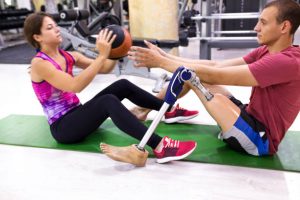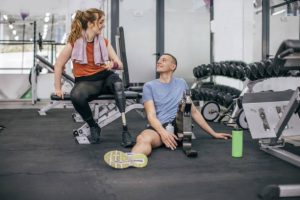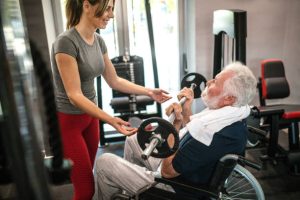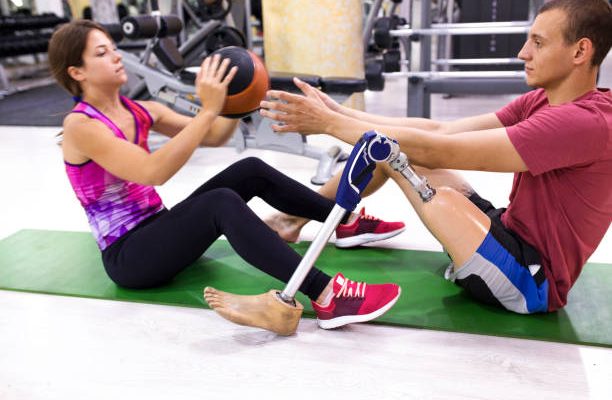Welcome to our blog post on free gym membership for disabled community! In today’s society, it is crucial to ensure equal access and opportunities for individuals with disabilities. Unfortunately, when it comes to fitness and wellness, there are still barriers that prevent many disabled people from enjoying the benefits of a gym membership, including a lack of affordability. However, we firmly believe everyone deserves the chance to pursue their health goals without limitations. That’s why we’re here to explore the current state of free gym memberships for the disabled community and discuss how making these memberships more accessible can positively impact lives. So let’s dive in and discover how we can break down those barriers together!
What Is The Current State Of Gym Memberships For The Disabled Community?
Contents
Gym memberships for the disabled community have come a long way, but there is still work to be done. Many gyms now offer accessible equipment and facilities, making it easier for individuals with disabilities to engage in physical activity. However, despite these improvements, there are still challenges that prevent full inclusion.

One significant issue is the cost of gym memberships. While some disabled individuals may qualify for financial assistance or government programs, many still struggle to afford the fees associated with joining a gym. This financial barrier can limit their ability to participate in regular exercise and reap its numerous health benefits.
Another challenge is the lack of specialized training and support available at mainstream gyms. Although staff members are generally knowledgeable about fitness techniques, they may not have specific expertise in adapting exercises for different disabilities. This can create an environment where disabled individuals feel excluded or unsure about how to navigate their workout routine safely.
Furthermore, accessibility remains a concern at some gyms. While progress has been made in terms of wheelchair ramps and accessible bathrooms, there can still be limitations when it comes to certain areas within the facility or equipment that caters specifically to different disabilities.
While strides have been made towards inclusivity in gym memberships for the disabled community, there is room for improvement across various aspects such as affordability, specialized training support from staff members,and ensuring comprehensive accessibility throughout all areas of a gym facility
Why Are Free Gym Memberships Important For The Disabled Community?
Free gym memberships are incredibly important for the disabled community because they provide equal access to fitness and wellness resources. Physical activity is crucial for everyone’s well-being, including individuals with disabilities. Regular exercise can improve physical strength, flexibility, and cardiovascular health while also boosting mental well-being.

However, many disabled individuals face financial barriers that prevent them from accessing gym facilities and equipment. Medical expenses and additional costs associated with disabilities can be overwhelming, making it difficult to prioritize fitness. By offering free gym memberships specifically tailored to the needs of disabled individuals, we can remove this financial burden.
Furthermore, having access to a supportive and inclusive fitness environment is essential for those with disabilities. Many gyms lack proper accessibility features such as ramps or accessible workout equipment. Free gym memberships dedicated to the disabled community ensure that these amenities are available without any added cost.
Additionally, free gym memberships encourage social engagement among people with disabilities by providing opportunities for them to connect with others who share similar experiences and goals. This sense of community fosters motivation and support in achieving their fitness objectives.
By promoting free gym memberships for the disabled community, we can create an inclusive society that values everyone’s right to lead a healthy lifestyle regardless of their abilities or economic circumstances.
What Are Some Of The Barriers To Disabled People Accessing Gym Memberships?
One of the barriers that disabled people face when accessing gym memberships is a lack of accessible facilities and equipment. Many gyms do not have the necessary accommodations for individuals with disabilities, such as wheelchair ramps or modified exercise machines. This can make it difficult for disabled individuals to navigate and participate in fitness activities.
Another barrier is the cost associated with gym memberships. Disabled individuals often face additional financial burdens related to their disability, making it challenging to afford monthly membership fees. This can be particularly true for those who are on fixed incomes or rely on disability benefits as their primary source of income.
Additionally, there may be a lack of knowledgeable staff trained in working with disabled individuals at some gyms. It is crucial for gym employees to understand how to assist and support people with disabilities during their workouts, ensuring they can safely engage in physical activity.
Transportation can also present a significant barrier for disabled individuals trying to access gym facilities. Public transportation systems may not always be fully accessible or reliable, making it challenging for some people with disabilities to travel independently to the gym.
Social stigma and discrimination play a role in deterring disabled individuals from pursuing gym memberships. There may be misconceptions about what a person with a disability is capable of achieving physically, leading them to feel unwelcome or judged within traditional fitness spaces.
Addressing these barriers requires collaboration between gyms and advocacy organizations focused on inclusivity and accessibility. By providing more accessible facilities, offering discounted or free membership options tailored towards those with disabilities, training staff members on working with diverse populations, improving transportation options near gyms, and promoting inclusive environments through education and awareness campaigns—more opportunities will open up for disabled community members seeking improved health through fitness pursuits.
How Can We Make Gym Memberships More Accessible For Disabled People?
When it comes to making gym memberships more accessible for disabled people, there are several key considerations that can greatly improve inclusivity and ensure equal opportunities for all. One of the first steps is to provide a range of adaptive equipment specifically designed to meet the needs of different disabilities. This can include wheelchair-accessible exercise machines, modified weightlifting equipment, and specialized cardio machines with adjustable settings.

In addition to physical accessibility, it’s important to offer comprehensive staff training on disability awareness and inclusion. By educating gym employees about various disabilities and how they may affect individuals’ abilities to use certain equipment or participate in specific exercises, staff members can better assist disabled members in navigating the gym environment.
Furthermore, implementing policies that prioritize reasonable modifications or accommodations for disabled individuals is crucial. This might involve offering flexible membership options such as discounted rates or pay-as-you-go plans for those who require intermittent access due to medical appointments or treatments.
To further enhance accessibility, gyms could also consider partnering with local disability organizations or advocacy groups. By collaborating with these organizations, gyms can gain valuable insights into best practices for accommodating diverse needs and raise awareness within their communities about inclusive fitness opportunities.
By investing in adaptive equipment, providing comprehensive staff training on disability inclusion, offering flexible membership options, and establishing partnerships with disability organizations, gym memberships can become significantly more accessible for disabled people.
The key lies not only in physical modifications but also in fostering a culture of inclusivity where everyone feels welcome and empowered to achieve their fitness goals.
Conclusion
Providing free gym memberships for the disabled community is crucial in promoting inclusivity and overall well-being. Currently, the accessibility of gyms for people with disabilities remains a challenge due to physical barriers, lack of specialized equipment, and financial constraints. However, by offering free memberships tailored to meet their specific needs and addressing these barriers head-on, we can empower individuals with disabilities to lead healthier lives. By removing the financial burden associated with gym memberships, we open up opportunities for individuals with disabilities to take part in exercise programs that improve their physical health and mental well-being. Accessible facilities equipped with adaptive machines and trained staff will ensure that they feel safe and supported while pursuing their fitness goals.
